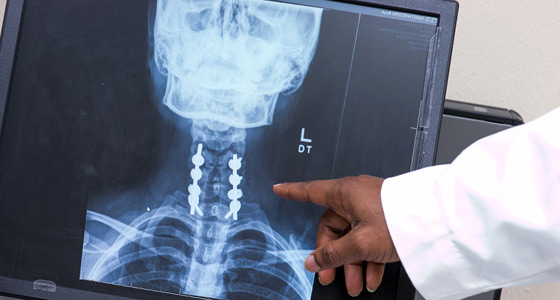Operating with little room for error
In the hospital waiting room, Kayla Cameron couldn’t hold back the tears.
Weeks earlier, Cameron, 22, had been critically injured in a car crash that fractured her spinal column and put her at risk of paralysis. On this day, she was to meet Douglas Dickson, MD, the orthopedic surgeon who performed an emergency spinal fusion surgery on her.
“As soon as Dr. Dickson walked up, I cried and hugged him,” Cameron recalled. “Then I looked around and all the other patients waiting there were crying, too.”
That Cameron was able to rise and embrace Dr. Dickson, Assistant Professor of Orthopaedic Surgery at UNTHSC, was a testament to his skilled and compassionate care. Before her Aug. 20 accident, Cameron, a shift manager at a grocery store, was an active young woman who loved taking dance classes at the gym. Suddenly, she was strapped into a cervical collar at John Peter Smith Hospital, wondering if she would walk again.
Cameron’s parents and boyfriend rushed to JPS to learn that Cameron’s fractures were a mere two millimeters from her spinal cord. It was so unstable that further damage could occur at any time and cause paralysis.
“They had to do surgery, but that was risky because just moving her slightly wrong would make it worse,” said her mother, Michelle Cameron. “We were very scared.”

Enter Dr. Dickson, who practices at JPS, Tarrant County’s only Level 1 Trauma Center. First, he and his team suspended weights to keep her stable. Then he made a midline incision and, using a microscope, inserted eight screws and two rods to secure the fracture. The surgical team scrutinized her neurophysiological signals to ensure no damage occurred to her spinal cord.
“You’re working very close to the spine, so there is very little room for error,” Dr. Dickson said.
After three hours, Dr. Dickson emerged and told Cameron’s family the surgery was a success, then joined them in a prayer for her recovery.
Today, Cameron’s neck brace is off. She undergoes physical therapy once a week to strengthen her back and neck muscles so she can return to work.
At a follow-up appointment, Cameron grew teary again as Dr. Dickson used a model spinal column to demonstrate her injury. Wiping a tear, Cameron thanked him for his exceptional care.
“You’re my hero,” she said.







Social media